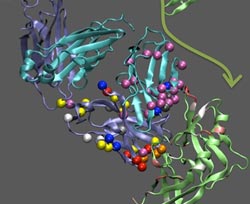Antibody evolution could guide HIV vaccine development

Co-evolution of virus and antibody – The evolution of the viral protein (green) from 14 weeks through 100 weeks post-transmission is compared to the maturation of the human antibody. Image courtesy Los Alamos National Laboratory.<br>
Observing the evolution of a particular type of antibody in an infected HIV-1 patient, a study spearheaded by Duke University, including analysis from Los Alamos National Laboratory, has provided insights that will enable vaccination strategies that mimic the actual antibody development within the body.
The kind of antibody studied is called a broadly cross-reactive neutralizing antibody, and details of its generation could provide a blueprint for effective vaccination, according to the study’s authors. In a paper published online in Nature this week, the team reported on the isolation, evolution and structure of a broadly neutralizing antibody from an African donor followed from the time of infection.
The observations trace the co-evolution of the virus and antibodies, ultimately leading to the development of a strain of the potent antibodies in this subject, and they could provide insights into strategies to elicit similar antibodies by vaccination.
Patients early in HIV-1 infection have primarily a single “founder” form of the virus that has been strong enough to infect the patient, even though the population in the originating patient is usually far more diverse and contains a wide variety of HIV mutations. Once the founder virus is involved in the new patient’s system, the surrounding environment stimulates the HIV to mutate and form a unique, tailored population of virus that is specific to the individual.
The team, including Bette Korber, Peter Hraber, and S. Gnanakaran, of Los Alamos National Laboratory, led by Barton Haynes of Duke University School of Medicine in Durham, North Carolina, with colleagues at Boston University, the National Institutes of Health, and other institutions as part of a large collaboration, showed that broadly neutralizing antibodies developed only after the population of viruses in the individual had matured and become more diverse.
“Our hope is that a vaccine based on the series of HIV variants that evolved within this subject, that were together capable of stimulating this potent broad antibody response in his natural infection, may enable triggering similar protective antibody responses in vaccines,” said Bette Korber, leader of the Los Alamos team.
The research, “Co-evolution of a broadly neutralizing HIV-1 antibody and founder virus,” is online.
This study was supported by the National Institutes of Allergy and Infectious Diseases (NIAID) and by intramural National Institutes of Health (NIH) support for the NIAID Vaccine Research Center, by grants from the NIH, NIAID, AI067854 (the Center for HIV/AIDS Vaccine Immunology) and AI100645 (the Center for Vaccine Immunology-Immunogen Discovery). Use of sector 22 (Southeast Region Collaborative Access team) at the Advanced Photon Source at Argonne National Laboratory was supported by the US Department of Energy, Basic Energy Sciences, Office of Science, under contract number W-31-109-Eng-38.
Media Contact
More Information:
http://www.lanl.govAll latest news from the category: Health and Medicine
This subject area encompasses research and studies in the field of human medicine.
Among the wide-ranging list of topics covered here are anesthesiology, anatomy, surgery, human genetics, hygiene and environmental medicine, internal medicine, neurology, pharmacology, physiology, urology and dental medicine.
Newest articles

Microscopic basis of a new form of quantum magnetism
Not all magnets are the same. When we think of magnetism, we often think of magnets that stick to a refrigerator’s door. For these types of magnets, the electronic interactions…

An epigenome editing toolkit to dissect the mechanisms of gene regulation
A study from the Hackett group at EMBL Rome led to the development of a powerful epigenetic editing technology, which unlocks the ability to precisely program chromatin modifications. Understanding how…

NASA selects UF mission to better track the Earth’s water and ice
NASA has selected a team of University of Florida aerospace engineers to pursue a groundbreaking $12 million mission aimed at improving the way we track changes in Earth’s structures, such…





















